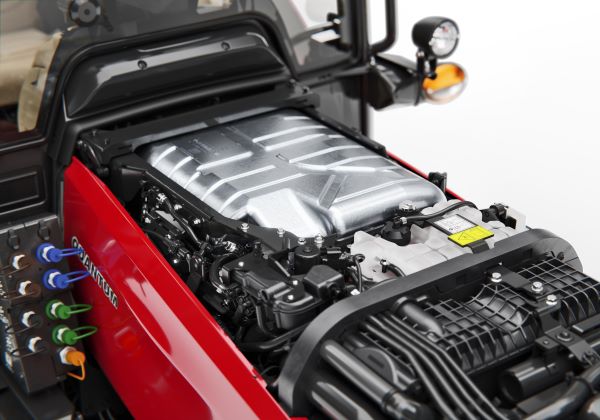The world over, manufacturers of engines for the off-highway markets are having to stay on top of legal requirements for emissions reduction. While ever lower emissions benefit the environment, emissions reduction poses a growing technical challenge for mobile machinery. From November 12 to 18, the Systems & Components event, within Agritechnica, in Hanover, Germany, will showcase the progress technology suppliers have made to optimize drive systems and engines regarding fuel consumption and emissions.
Because of the need for large load capacity and uninterrupted operation, mobile machinery requires fuels with high energy density. As a result, the leading manufacturers in the off-highway sector are investing in customizable combinations of diesel, gas, hydrogen and electric. The modular product portfolios presented at Systems & Components are suitable for all types of off-highway machinery and enable a flexible response to technological developments in the respective markets. Nevertheless, the diesel engine is likely to remain the most widely used powertrain in agricultural and construction machinery for some time yet. Robustness, low operating costs and simple refueling are the reasons for its enduring appeal.
High power density, clean exhaust
Industry-leading companies such as Bosch assume that 80 percent of all new construction machinery over 56 kilowatts worldwide will still be equipped with a “diesel” engine in 2035. At the Systems & Components trade fair in Hanover, technology suppliers will be demonstrating how combustion engines can make a greater contribution to climate protection in the off-highway sector in the future. A prerequisite for this is being able to adapt to new emission standards and finding solutions that reduce fuel consumption and overall costs in equal measure. Most recently, the lowering of limits in the European Stage V emissions standard, led to an adjustment in engines. To meet the regulations, technology suppliers have now almost completely eliminated nitrogen oxide emissions and particulates, which required the lowest possible raw emissions from the engine. As a result, many of the diesel engines presented in Hanover are new developments that incorporate components such as turbochargers, intercoolers and common-rail systems. These high-efficiency designs employ combustion without exhaust-gas recirculation, coupled with high cylinder pressure and high injection pressures. Engines equipped with the latest generation of common-rail systems now have peak pressures of up to 2,500 bar. Electronically controlled fans, which are standard in production engines, improve the cooling performance while reducing both fuel consumption and noise levels.
Through the use of synthetic fuels, all these diesel-based systems can already make a significant contribution to CO2 reduction. Deutz, for example, has approved its entire TCD engine range for use with alternative diesel fuels. This means that all engines in EU emission class V up to the new TCD 5.2 series are approved for operation with paraffinic diesel fuels in accordance with the EN 15940 specification, such as HVO (Hydrotreated Vegetable Oil) – an advanced biofuel produced from biological waste materials, liquid manure, used cooking oils and fats that does not compete with food production. The use of such HVO fuels improves the carbon footprint of engines by up to 95 percent.
Nitrogen oxide reduction by means of SCR
At System & Components, you will also find all the components required for highly effective exhaust gas aftertreatment in order to implement Stage V systems for a wide range of off-highway applications, including a wide range of solutions for both OEMs and aftermarket. As well as combinations of diesel oxidation catalysts (DOC) and diesel particulate filters (DPF) that are easy to maintain, the main focus is on exhaust gas sensors, dosage modules and metallic catalyst carriers for selective catalytic reduction (SCR). HI-eSCR from FPT Industrial is representative of this – a highly efficient catalytic converter that reduces the nitrogen oxides contained in the exhaust gas by over 95 percent and converts them into water and nitrogen, both harmless elements. For this purpose, AdBlue, a colorless mixture of water and urea, is added to the exhaust gas stream in the aftertreatment system as a reducing agent. The solution is converted in the exhaust gas stream to ammonia, which plays a decisive role in reducing nitrogen oxides. The entire system is monitored by an engine control unit, which determines the precise amount of AdBlue that needs to be added, based on sensor measurements of the exhaust gas composition.
To further reduce NOx emissions, Bosch has improved its SCR technology for exhaust gas aftertreatment. A double dosing system combined with high-performance temperature management allows nitrogen oxides to be further reduced. Depending on the operating situation, the SCR system injects urea into a catalytic converter close to the engine and one far from the engine. The second injection helps to ensure almost complete conversion of the nitrogen oxides even at full load.
The hydrogen engine is a climate-neutral propulsion system for off-highway vehicles but, even here, SCR technology offers great potential , as the exhaust gas still contain nitrogen oxide and small amounts of particulates and unburned hydrocarbons from the engine oil path. With the H2-ICE exhaust gas purification system, the specialists of the Eberspächer Group have a system in their portfolio that has been specifically designed for hydrogen engines. The technology has been adapted from nitrogen oxide conversion in fossil fuel applications.
Alternative drive concepts in the fast lane
The advantage of hydrogen as a fuel in mobile machinery is its exceptionally clean combustion: the carbon dioxide emissions of hydrogen engines are close to zero – because hydrogen, unlike diesel, contains no carbon. Several companies have already presented hydrogen-powered prototypes that do not use fuel cell technology, such as Deutz with its TCG 7.8 H2. At Systems & Components, various engine manufacturers, including Cummings, will be demonstrating exciting developments in carbon-free combustion engine technology, based around efficient injection, lean-burn processes, exhaust gas recirculation, turbocharging and special hydrogen catalysts. For construction and agricultural machinery manufacturers such as Liebherr, JCB or Fendt, the main attraction of this technology is that conventional internal combustion engines need no major structural modifications to work with hydrogen. This reduces the development effort significantly and enables the further marketing of current machine models that are not suitable for electric drive according to the current state of the art. In addition, green hydrogen, generated from renewable electricity, ensures the drive is virtually climate neutral.
As a results, both efficiency and the legal requirements on exhaust emissions continue to be technology drivers for mobile machinery and environmentally friendly drive concepts for off-highway applications are more important than ever. Hybrid concepts that combine low-emission engines with electric drives open up significant efficiency potential in the powertrain, a trend that will also be reflected at Systems & Components from November 12 to 18. Machine manufacturers can select the optimum combination of conventional and electric drive components for their application on a modular basis








